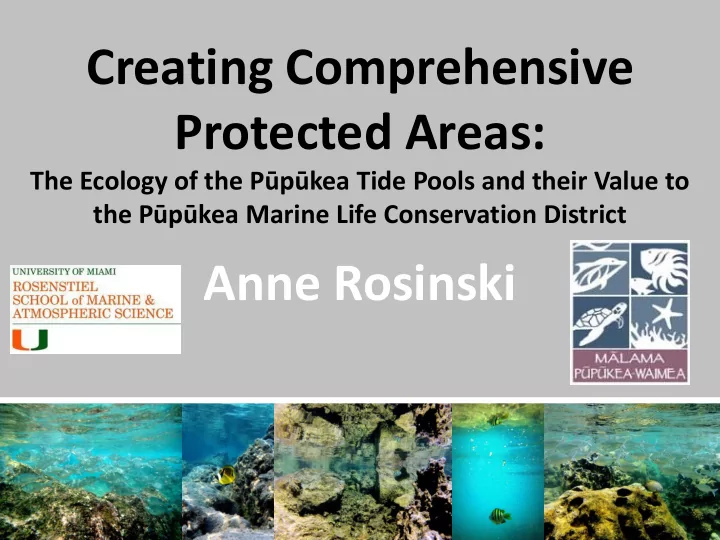

Creating Comprehensive Protected Areas: The Ecology of the Pūpūkea Tide Pools and their Value to the Pūpūkea Marine Life Conservation District Anne Rosinski
Nearshore Ecology: Hawai ’ i • Vital coastal zone area including: TIDE POOL habitat • Tide pool can serve several ecological functions • Fish nursery, food/shelter, connection to deeper reefs Methods Results Discussion Introduction Conclusions Questions
Pūpūkea Tide Pools • Marine Life Conservation District (MLCD) • Boundary change and administrative rules • 1975: Last baseline of tide pools by Kimmerer & Durbin Methods Results Discussion Introduction Conclusions Questions
This Study 1. Update 1975 ecological baseline in Pūpūkea tide pools 2. Compare findings to Shark’s Cove and other tide pools around O ’ ahu 3. Make recommendations on future legal efforts concerning administrative rules Methods Results Discussion Introduction Conclusions Questions
Measuring the Biological Variables • Used visual transects • Measured # of fish and invertebrates and # of species • Presence/absence of coral species • Depth, tide, date, and time were recorded Methods Results Discussion Introduction Conclusions Questions
Measuring the Environmental Variables • Temperature Loggers • Measured temperature and salinity at 25 random locations • Depth measured at transect locations • Correlation of environmental variables to tide pool biology Methods Results Discussion Introduction Conclusions Questions
Results: Biological Baseline FISH 42 species, 21 families 1. Āholehole 2. Manini 3. Uouoa INVERTEBRATES 26 species 1. ‘Ina 2. Teated sea cucumber 3. Wana Methods Discussion Introduction Results Conclusions Questions
Results: Biological Baseline Fish Species Richness Fish Abundance Invert Abundance Less Less Less More More More Discussion Introduction Methods Results Conclusions Questions
Results: Biological Baseline Day Night 1. ‘Ina 1. ‘Ina 2. Teated sea 2. Sea hare cucumber 3. Wana 3. Polyplectana kefersteini
Results: Biological Baseline Cauli- Coral Species Richness False flower Finger Brain Less Mound Lace More Rice Lobe Methods Discussion Introduction Results Conclusions Questions
Results: Environmental Variables Temperature Loggers 83.8 (°F) Corals 82.4 become stressed! 79.7 75.5 Methods Discussion Introduction Results Conclusions Questions
Results: Environmental Variables Temperature Loggers 30 28 Temp (°C) 26 24 Temperature Profile from Logger in shallow water Methods Discussion Introduction Results Conclusions Questions
Results: Environmental Variables Temperature and Salinity Grid Sampling Grid Less Colder More Warmer Methods Discussion Introduction Results Conclusions Questions
Results: Depth Measurements Depth (m) Deep Shallow Methods Discussion Introduction Results Conclusions Questions
Results: Relationships Fish Abundance increases: Shallow water Rising/falling tide Total (fish + invertebrate) Abundance increases: Deeper water Lower salinity Methods Discussion Introduction Results Conclusions Questions
Results: Site Comparisons Pūpūkea tide pools compared to… * Similar fish abundance and number of Shark’s Cove species per transect * 14% increase in fish species observed, 1975 Baseline similar salinity range Other Tide * Highest number of fish species observed, different fish composition, Pools on Oahu lower avg. salinity Methods Discussion Introduction Results Conclusions Questions
Important Biological Findings • Depth and tide relationship similar to other research (Mahon & Mahon 1994, Gibson & Yoshiyama 1999, Davis 2000, Castellanos-Galindo et al. 2005, Rojas & Ojeda 2010) • Unique Salinity and fish composition • Āholehole and Manini • Evidence of juvenile fish habitat Discussion Methods Results Introduction Conclusions Questions
Legal Options 1. Community meeting 2. Public hearing with DAR 3. HAR §13-1-26 Petitions for adoption, amendment, or repeal of rules 4. Continue education and outreach activities Methods Results Conclusions Introduction Discussion Questions
Life Update: Future Involvement • Graduation from U. Miami • NOAA Coral Reef Management Fellowship: Hawaii DAR • Makai Watch Biological Monitoring Guidelines • Hawaii Conservation Conference • MPW Tide Pool Monitoring training
Mahalo! Committee, Colleagues, Family, and Friends
Questions
Recommend
More recommend